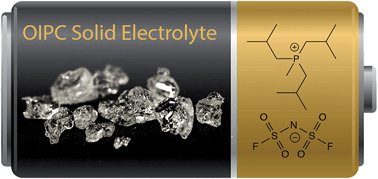An organic ionic plastic crystal electrolyte for rate capability and stability of ambient temperature lithium batteries†
Abstract
Reliable, safe and high performance solid electrolytes are a critical step in the advancement of high energy density secondary batteries. In the present work we demonstrate a novel solid electrolyte based on the organic ionic plastic crystal (OIPC) triisobutyl(methyl)phosphonium bis(fluorosulfonyl)imide (P1444FSI). With the addition of 4 mol% LiFSI, the OIPC shows a high conductivity of 0.26 mS cm−1 at 22 °C. The ion transport mechanisms have been rationalized by compiling thermal phase behaviour and crystal structure information obtained by variable temperature synchrotron X-ray diffraction. With a large electrochemical window (ca. 6 V) and importantly, the formation of a stable and highly conductive solid electrolyte interphase (SEI), we were able to cycle lithium cells (Li|LiFePO4) at 30 °C and 20 °C at rates of up to 1 C with good capacity retention. At the 0.1 C rate, about 160 mA h g−1 discharge capacity was achieved at 20 °C, which is the highest for OIPC based cells to date. It is anticipated that these small phosphonium cation and [FSI] anion based OIPCs will show increasing significance in the field of solid electrolytes.


 Please wait while we load your content...
Please wait while we load your content...